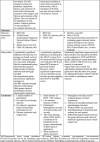Transcranial Direct Current Stimulation in Conjunction with Mirror Therapy for Upper Extremity Rehabilitation in Chronic Stroke Patients
- PMID: 35733745
- PMCID: PMC9168586
- DOI: 10.26574/maedica.2022.17.1.169
Transcranial Direct Current Stimulation in Conjunction with Mirror Therapy for Upper Extremity Rehabilitation in Chronic Stroke Patients
Abstract
Objective: Stroke represents a major cause of upper limb motor impairment among stroke survivors, resulting in functional disability and affecting negatively their quality of life. Thus, it is imperative that stroke rehabilitation be efficient. Up to the present, several intervention methods have been proposed in an attempt to improve recovery potential poststroke, transcranial direct current stimulation (tDCS) and mirror therapy (MT) being among them. The aim of this review is to investigate the utility of tDCS administration in conjunction with MT on chronic stroke population. Methods: A literature research of two databases (MEDLINE and Scopus) was conducted in order to identify all relevant studies published between January 1st 2010 and September 30th 2021 that focused on the efficacy of the combined application of tDCS and MT on upper limb rehabilitation among chronic stroke patients. Results: Three studies fulfilled the selection criteria and were included in the present review. Transcranial direct current stimulation application along with MT exhibited statistically significant increases in Box and block test, grip strength, Action research arm test score and Nottingham extended activities of daily living score within the experimental group compared to controls. The timing-dependent interaction effects seem to be of key importance, as sequentially delivered tDCS prior to MT is considered to be more advantageous and time-efficient compared to the concurrent application of tDCS and MT. Conclusions: Application of tDCS in parallel with MT represents a promising neurorehabilitation tool for post-stroke patients regarding upper limb motor performance, movement efficiency and daily function. Future studies are needed in order to clarify whether sequential or concurrent tDCS and MT application is more beneficial.
Figures
Similar articles
-
Timing-dependent effects of transcranial direct current stimulation with mirror therapy on daily function and motor control in chronic stroke: a randomized controlled pilot study.J Neuroeng Rehabil. 2020 Jul 20;17(1):101. doi: 10.1186/s12984-020-00722-1. J Neuroeng Rehabil. 2020. PMID: 32690032 Free PMC article. Clinical Trial.
-
Timing-dependent interaction effects of tDCS with mirror therapy on upper extremity motor recovery in patients with chronic stroke: A randomized controlled pilot study.J Neurol Sci. 2019 Oct 15;405:116436. doi: 10.1016/j.jns.2019.116436. Epub 2019 Aug 29. J Neurol Sci. 2019. PMID: 31493725 Clinical Trial.
-
Efficacy, safety, and tolerability of bilateral transcranial direct current stimulation combined to a resistance training program in chronic stroke survivors: A double-blind, randomized, placebo-controlled pilot study.Restor Neurol Neurosci. 2019;37(4):333-346. doi: 10.3233/RNN-190908. Restor Neurol Neurosci. 2019. PMID: 31227673 Clinical Trial.
-
Combined transcranial Direct Current Stimulation and robot-assisted arm training in patients with stroke: a systematic review.Restor Neurol Neurosci. 2021;39(6):435-446. doi: 10.3233/RNN-211218. Restor Neurol Neurosci. 2021. PMID: 34974446
-
Non-invasive brain stimulation associated mirror therapy for upper-limb rehabilitation after stroke: Systematic review and meta-analysis of randomized clinical trials.Front Neurol. 2022 Jul 19;13:918956. doi: 10.3389/fneur.2022.918956. eCollection 2022. Front Neurol. 2022. PMID: 35928134 Free PMC article.
Cited by
-
Conjunct Effects of Transcranial Direct Current Stimulation with Mirror Therapy on Motor Control and Muscle Performance in Spastic Quadriplegic Cerebral Palsy Children: A Randomized Clinical Trial.J Multidiscip Healthc. 2025 Feb 27;18:1195-1216. doi: 10.2147/JMDH.S506784. eCollection 2025. J Multidiscip Healthc. 2025. PMID: 40035031 Free PMC article.
-
How does combining physical therapy with transcranial direct stimulation improve upper-limb motor functions in patients with stroke? A theory perspective.Ann Med Surg (Lond). 2024 Jun 19;86(8):4601-4607. doi: 10.1097/MS9.0000000000002287. eCollection 2024 Aug. Ann Med Surg (Lond). 2024. PMID: 39118708 Free PMC article. Review.
References
-
- Katan M, Luft A. Global burden of stroke. Semin Neurol. 2018;38:208–211. - PubMed
-
- Adamson J, Beswick A, Ebrahim S. Is stroke the most common cause of disability? J Stroke Cerebrovasc Dis. 2004;13:171–177. - PubMed
-
- Katzan I, Thompson N, Uchino K, Lapin B. The most affected health domains after ischemic stroke. Neurology. 2018;90:e1364–e1371. - PubMed
Publication types
LinkOut - more resources
Full Text Sources



